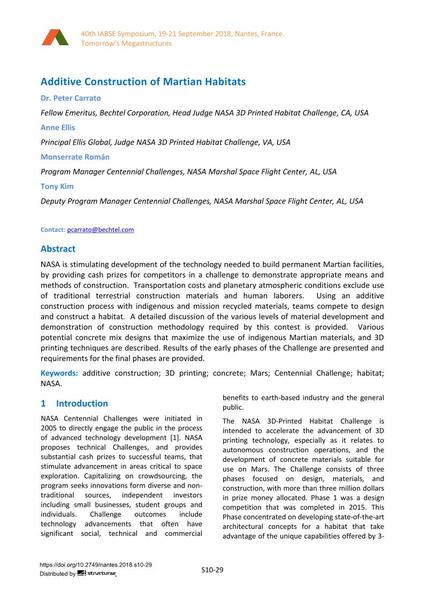Additive Construction of Martian Habitats

|
|
|||||||||||
Détails bibliographiques
| Auteur(s): |
Peter Carrato
(Fellow Emeritus, Bechtel Corporation, Head Judge NASA 3D Printed Habitat Challenge, CA, USA)
Anne Ellis (Principal Ellis Global, Judge NASA 3D Printed Habitat Challenge, VA, USA) Monserrate Román (Program Manager Centennial Challenges, NASA Marshal Space Flight Center, AL, USA) Tony Kim (Deputy Program Manager Centennial Challenges, NASA Marshal Space Flight Center, AL, USA) |
||||
|---|---|---|---|---|---|
| Médium: | papier de conférence | ||||
| Langue(s): | anglais | ||||
| Conférence: | IABSE Symposium: Tomorrow’s Megastructures, Nantes, France, 19-21 September 2018 | ||||
| Publié dans: | IABSE Symposium Nantes 2018 | ||||
|
|||||
| Page(s): | S10-29 | ||||
| Nombre total de pages (du PDF): | 8 | ||||
| DOI: | 10.2749/nantes.2018.s10-29 | ||||
| Abstrait: |
NASA is stimulating development of the technology needed to build permanent Martian facilities, by providing cash prizes for competitors in a challenge to demonstrate appropriate means and methods of construction. Transportation costs and planetary atmospheric conditions exclude use of traditional terrestrial construction materials and human laborers. Using an additive construction process with indigenous and mission recycled materials, teams compete to design and construct a habitat. A detailed discussion of the various levels of material development and demonstration of construction methodology required by this contest is provided. Various potential concrete mix designs that maximize the use of indigenous Martian materials, and 3D printing techniques are described. Results of the early phases of the Challenge are presented and requirements for the final phases are provided. |
||||
| Mots-clé: |
béton
|
||||
